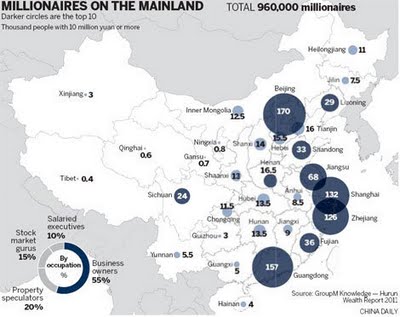Who are these people?
According to the white paper, Beijing was home to 170,000 multimillionaires and 10,000 billionaires, ranking it first on the list of cities with the most multimillionaires in China, followed by Shanghai, Shenzhen, Hangzhou, Guangzhou, Wenzhou, Chengdu and Nanjing.
Generally speaking, the sex ratio of the multimillionaires was 7 to 3, most of whom owned a large proportion of real estate, as well as other major assets including investments, stock shares and personal collections.
Most Chinese millionaires were born in 1972, making them 39 years old today – a full fifteen years younger than their Western counterparts.
As many as 55% of the 960,000 multimillionaires were entrepreneurs who got their wealth from private businesses, while 20% were property speculators who benefited from the real estate market. 15% were stock experts and 10% were high-earning executives in prestigious companies.
The Chinese Luxury Traveler White Paper by the HRI and the International Luxury Travel Market showed that luxury goods, travel and children's education had become the main targets of spending for China's wealthiest people, with one-third of them being female.
Travel accounted for the largest part of their spending. The top domestic destinations were Sanya (Hainan province), Hong Kong and Yunnan province, while favorite overseas destinations included France, the U.S. and Australia.
In addition, shopping was a key part of their spending, and top items included watches, jewelry, clothes and accessories. It was reported that on average they owned over three cars and 3.7 to 4.6 watches. They also enjoyed collecting luxury watches, works of Chinese classical art and calligraphy, as well as liquor.
Many of them preferred to send their children to study abroad, while more than half of China's multimillionaires were considering becoming immigrant investors.
Wealth gap needs to be narrowed
Even as the number of Chinese multimillionaires surges, many people's lives have not been improved by the country's economic growth. Some poor farmers struggle to survive on less than $1 a day in the countryside.
Although China has managed to sustain high-speed economic growth since its reform and opening-up, and made noteworthy achievements in improving people's livelihoods, too many people are left scraping by with hardly enough to eat.
The government is now making efforts to track rapid market changes and keep Chinese millionaires and their money from leaking out of the country. It also plans to increase residents' income and ensure synchronous growth with economic development. We can only hope that this strategy will begin to narrow the wealth gap.


















